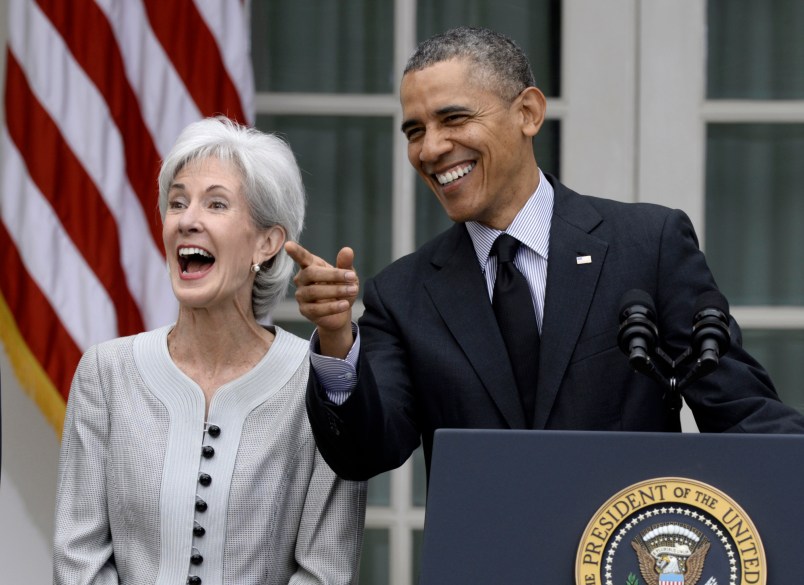Health and Human Services Secretary Kathleen Sebelius, the lightning rod for Obamacare’s troubled rollout last fall, has resigned. During her five years heading HHS, she oversaw a fundamental transformation of the U.S. health care system. Considering she was never supposed to serve as secretary at all, she’ll depart having left an indelible mark on the Obama administration.
Her tenure will be, in many ways, defined by two setbacks that could have been avoided and almost completely discredited the law in the public eyes — and by her uncanny ability to bring Obamacare back from the brink and leave the law in as good of shape as it could be.
Her appearance Friday with President Barack Obama and her chosen successor, Office of Budget and Management Director Sylvia Mathews Burwell, had a celebratory tone. The president touted the historic implications of the law and Sebelius’s final achievement of 7.5 million Obamacare sign-ups. About a half dozen standing ovations from HHS and White House officials greeted her.
But implicit in their remarks was a recognition that the law’s implementation had not gone as smoothly as it could have. And, for the foreseeable future, it is likely that mix of commendation for her successes and a linger memory of her failures that will define Sebelius’s legacy.
“Kathleen has been here through the long fight of the implementation of the health care act,” Obama said in the White House Rose Garden. “And it has been long and rough, and she has bumps, and I have got bruises and bumps.”
“We lost the first quarter of open enrollment period with the website problems. And they were problems. But under the leadership of Kathleen Sebelius, her team at HHS turned the corner, got it fixed, got the job done, and the final score speaks for itself,” he continued. “There are 7-and-a-half-million people across the country that have the security of health insurance and most of them for very first time, and that is because of the woman standing beside me. We are proud of that. That is a historic achievement.”
It is, of course, prudent to note that Sebelius was simply the head of a large department — not the person solely responsible for the law’s rollout — but, fair or unfair, she was the public face of it and it was her resignation that congressional Republicans were asking for.
Two items of the Obamacare implementation checklist did go horribly wrong.
First, HealthCare.gov flopped on a historic scale when it launched on Oct. 1. The most telling sign: Only 30,000 people signed up through the federal website in October, and the law ended its first enrollment month with one-fifth of the expected sign-ups.
Second, insurance cancellations went out across the country, telling millions of Americans that their current policy had been terminated. Republicans seized on Obama’s broken promise that “If you like your health plan, you can keep it” and the administration scrambled to respond. Over the next two months, Sebelius was subjected to congressional oversight hearings with Republican lawmakers, fresh off their own Obamacare-related PR disaster, practically gloating over the botched rollout.
Both of these political nightmares could have been avoided. HealthCare.gov’s failed debut launched a cottage industry of second-guessing and sniping through the media between the administration and the software firms responsible for the website’s construction. Everybody would agree, though, that it didn’t have to be a disaster from Day 1.
Likewise, the administration knew that insurance cancellations were coming under the law’s reforms. Policy wonks, including those sympathetic to the law’s goals, weren’t surprised. But, for whatever reason, Sebelius and the rest of the administration decided to ignore the issue until it became the political firestorm that defined the fall. Rather than prepare the American public, they let it be taken surprise — and the White House paid the price, as Obama and the law hit all-time lows in popularity.
But after those unnecessary missteps, Sebelius and the administration recovered. HealthCare.gov was fixed by the end of November, and enrollment has boomed since, surpassing the 7 million sign-ups threshold that most thought unattainable in October. HHS instituted an administrative ‘fix’ for those who had lost their existing health plan, and some new estimates have found that the number of people are uninsured because of a canceled policy is fewer than 1 million.
That allowed Sebelius to end on a high note in the Rose Garden. But, in some cruel cosmic jest, there was one more glitch for Sebelius. Her going-away remarks were missing a page. She paused, noted the problem for the audience and continued off-script. It was an impressive recovery.






